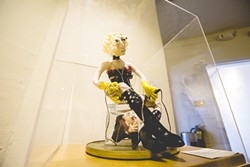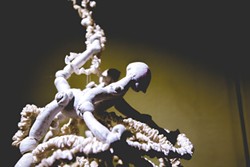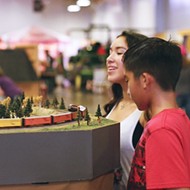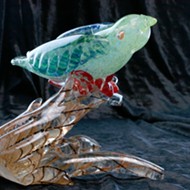The Central Coast Craftmakers unravel the mysteries of the bound object at SLOMA's
By Erin C. Messer[{
"name": "Ad - Medium Rectangle CC01 - 300x250",
"id": "AdMediumRectangleCC01300x250",
"class": "inlineCenter",
"insertPoint": "8",
"component": "2963441",
"requiredCountToDisplay": "12"
},{
"name": "Ad - Medium Rectangle LC01 - 300x250",
"id": "AdMediumRectangleCC01300x250",
"class": "inlineCenter",
"insertPoint": "18",
"component": "2963441",
"requiredCountToDisplay": "22"
},{
"name": "Ad - Medium Rectangle LC09 - 300x250",
"id": "AdMediumRectangleLC09300x250",
"class": "inlineCenter",
"insertPoint": "28",
"component": "3252660",
"requiredCountToDisplay": "32"
}]
We’re walking back to New Times’ offices from SLOMA after visiting the exhibit “To Have or Have Knot” when staff photographer Henry Bruington turns to me, completely straight-faced, and says:
“A little piece of string walks into a bar and orders a drink.”
I think you can see where this is going.
“The bartender takes one look at him and says, ‘Sorry pal, we don’t serve little pieces of string here.’
“So the piece of string goes back outside, ties himself up, and ruffles his hair. He walks back into the bar and orders another drink. The bartender says, ‘Hey, aren’t you that little piece of string I just kicked out of the bar?’
“‘Nope, I’m a frayed knot.’”
Why knots? They aren’t allowed in bars, and they aren’t usually invited into museums, either. The discipline of “artist topology,” as it is called on SLOMA’s website—or art knots—is by no means common to the world of fine arts, nor even to that of “fine crafts.” The rarity of vision implied by this theme is exactly what makes the exhibit so satisfying. Why knots? Why not!
Two embroidery-on-linen pieces by invited artist Mark Bieraugel are the highlight of the show. They strike that delicate balance between “fine art” and “fine craft,” visually referencing both accessible domestic objects and concept-based compositions. In the artist’s statement on his website, Bieraugel explains his attraction to the medium: “I like embroidery for the very deliberate aspect of doing each stitch, for the small hint of danger in working with a sharp needle, and for the tactile quality of working both on the surface and through the surface.”
The largest object in the exhibit is also the most verisimilar—one wonders if a fisherman somewhere might be missing part of his boat. Patricia Martin’s Rya Knot looks entirely from life; it’s hard to resist touching it. Its size makes it the antithesis of Richard Tuttle’s rope pieces (as seen in SLOMA’s recent screening of Herb & Dorothy), but it is just as easily mistaken for a non-art object. And yet “rya” rugs and other textiles play a significant role in modernist fiber arts movements, giving this piece more depth—both nautical and art-historical—than might at first be apparent.
Two artists’ books, Wine by Meryl Perloff and Fancy Fibers Journal by Judy Schuster, qualify for the show by virtue of their construction—the knots visible from their spines are literally the “ties that bind.” It’s not surprising that these two artists are able to emphasize such ties, as they also took first and second place, respectively, in the show for other pieces.
Ann Bonestell’s knotty pine encaustic panel Knot (Branch) recalls a knot in the throat. Kate Froman’s nearby Knot Scarf, a madras pattern in silk shantung, implies the interweaving of cultures as well as the history of fabric production. With a pattern design derived from India rendered in a textile with Chinese origins, this piece traces the silk road in irregular thread and points to a legacy of design both beautiful, but also highly fraught. Another of Froman’s pieces in the exhibit, Love Notes, makes a clearer reference—to “tying the knot.”
Across the room, Sheila Lynn’s Cloud Knotters on a Busy Day imagines a whimsical profession, the job description of which is immediately clear when looking at the sculpture.
Meryl Perloff’s Auschwitz, which took first place, presents an immediate emotional challenge by virtue of its subject matter. The “knots” in this piece are barbed wire, and the infamous sign “ARBEIT MACHT FREI” (“work will set you free”) is rendered in miniature above historical photographs. Auschwitz forces the viewer to engage and does the “work” of art by refusing to allow the atrocities it references to recede from memory.
The piece most desperate for attention is Edie Schneider’s Mildred Teaches Sam a Little Something About ‘Tying the Knot,’ a BDSM sculpture depicting a woman dressed in corset and knee-high boots towering over the dwarfed figure of a balding man trapped in a cube beneath her. Clearly intended for shock value, the piece does manage to amuse, but its execution is ultimately unsatisfying. For its $1,800 price tag, I recommend that the viewer instead draw inspiration by investing in his or her own first-class bondage gear to recreate the sculpture at home.
To Have or Have Knot ties itself off March 30, so unravel your plans and weave your way down to SLOMA ASAP—as sewn as possible.
Erin C. Messer knows how to whistle: you just put your lips together and blow. She can be reached at [email protected].











